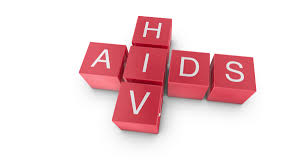
Table of Contents
AIDS (Acquired Immunodeficiency Syndrome) is the most advanced stage of HIV (Human Immunodeficiency Virus) infection. It weakens the immune system by attacking CD4 (T-helper) cells, leaving the body vulnerable to infections and cancers that a healthy immune system can normally fight.
Globally, around 39 million people were living with HIV in 2023 (UNAIDS). While treatments exist to manage HIV and stop its progression, there is still no permanent cure for AIDS. Awareness, prevention, and early diagnosis remain the strongest weapons in fighting this epidemic.
🔎 Causes / Risk Factors
HIV spreads when infected body fluids (blood, semen, vaginal fluids, breast milk) enter another person’s body. Main risk factors include:
- Unprotected sexual contact – Vaginal, anal, or oral sex without condoms.
- Sharing needles/syringes – Especially among drug users.
- Unsafe blood transfusions – Rare today due to screening, but still possible in poorly regulated areas.
- Mother-to-child transmission – During pregnancy, childbirth, or breastfeeding.
- Multiple sexual partners – Increases risk of exposure.
- Other STIs (Sexually Transmitted Infections) – Ulcers/sores from STIs make it easier for HIV to enter.
👉 HIV does NOT spread through hugging, kissing, shaking hands, sharing food, mosquito bites, or toilet seats.
⚠ Common Issues / Symptoms
HIV infection develops in three stages:
1. Acute HIV Infection (2–4 weeks after exposure)
- Fever, sore throat, and headache.
- Rash on body.
- Swollen lymph nodes.
- Muscle and joint pain.
(Often mistaken for flu — many don’t realize they are infected.)
2. Chronic HIV Infection (Clinical Latency)
- Few or no symptoms for years.
- The virus keeps damaging the immune system silently.
3. AIDS (Advanced Stage)
- Severe weight loss (wasting syndrome).
- Night sweats and recurring fever.
- Chronic diarrhea.
- Frequent infections (tuberculosis, pneumonia, fungal infections).
- Skin lesions or unusual cancers (Kaposi’s sarcoma).
- Neurological issues (memory loss, confusion).
⚠ Without treatment, HIV typically progresses to AIDS within 8–10 years.
📊 Table 1: Myths vs Facts
| Myths | Facts |
|---|---|
| AIDS spreads by casual contact (hugging, touching, sharing food) | HIV spreads only through blood, semen, vaginal fluids, breast milk |
| Mosquito bites spread HIV | Mosquitoes do not transmit HIV |
| Only sex workers/drug users get HIV | Anyone can get HIV without precautions |
| HIV means immediate death | With treatment (ART), people can live long, healthy lives |
| Condoms don’t work against HIV | Condoms are highly effective when used correctly |
📋 Table 2: Do’s and Don’ts
| Do’s ✅ | Don’ts ❌ |
|---|---|
| Use condoms during sexual activity | Have unprotected sex with multiple partners |
| Get tested regularly if at risk | Hide your HIV status from your partner |
| Use sterile needles/syringes | Share razors, needles, or syringes |
| Encourage awareness & counseling | Believe myths or stigmatize patients |
| Support HIV-positive people emotionally | Discriminate against HIV patients |
🌱 Prevention / Awareness Tips
- Always practice safe sex – Use condoms correctly every time.
- Get tested regularly – Early detection prevents spread.
- Avoid sharing needles – Use only sterile equipment.
- Ensure safe blood transfusion – Only from certified blood banks.
- Mother-to-child prevention – HIV-positive mothers can take medications to prevent passing HIV to the baby.
- Spread awareness, not stigma – Social support reduces risk behaviors and promotes early testing.
💊 Treatment / Care
There is no cure for HIV/AIDS, but treatment helps people live long, productive lives.
- ART (Antiretroviral Therapy): A combination of medicines that suppresses the virus, prevents AIDS, and reduces transmission.
- Regular Monitoring: CD4 cell count and viral load tests track progress.
- Opportunistic Infection Care: Treating TB, pneumonia, fungal infections, and cancers that affect weakened patients.
- Healthy Lifestyle: Good diet, exercise, stress management, and avoiding alcohol/smoking boost immunity.
⚡ With proper treatment, HIV-positive people can live as long as non-infected individuals.
📖 Case Study / Real-Life Example
In India, awareness and government programs have drastically reduced HIV cases. For example, the NACO (National AIDS Control Organization) introduced free ART programs, resulting in a 66% decline in new infections since 2000.
Stories of HIV-positive people living healthy, successful lives with treatment prove that HIV is no longer a death sentence — but a manageable condition.
❓ FAQs
Q1. Is HIV the same as AIDS?
A1. No. HIV is the virus; AIDS is the advanced stage of untreated HIV.
Q2. Can HIV be cured?
A2. Currently, no. But ART keeps the virus under control.
Q3. Can HIV-positive mothers have healthy babies?
A3. Yes, with proper medication, the risk of transmission can drop to less than 5%.
Q4. How often should I get tested?
A4. If you are sexually active or at risk, get tested every 6–12 months.
Q5. Can I marry if I have HIV?
A5. Yes, but safe sex and disclosure to the partner are essential.
Q6. Why is stigma around HIV dangerous?
A6. Stigma stops people from getting tested or treated, which increases spread.
🏁 Conclusion
AIDS is one of the biggest health challenges humanity has faced, but it is preventable and manageable. With awareness, safe practices, regular testing, and proper treatment, millions of lives can be saved.
💡 Remember: HIV does not discriminate, but neither should we. Awareness, prevention, and compassion are the strongest medicines against AIDS.
